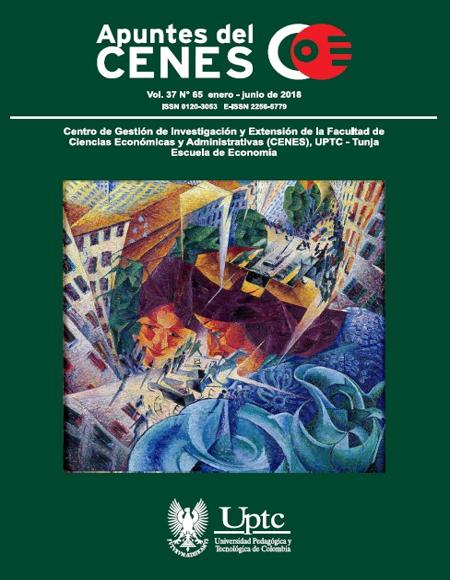Bilateral Trade Agreements: the Colombian Case (1990-2015)

Abstract
The proliferation of bilateral trade agreements has created a phenomenon known in the literature as “hub and spoke” bilateralism. In this context, Colombia’s trade policy is geared towards the signing of bilateral trade agreements. This article evaluates the policy of signing bilateral agreements implemented by Colombia between 1990 and 2015. We analyse trade flows between Colombia and several countries using Baldwin’s HM index of hub-ness (2004) and the matrix of Chen (2008). The results obtainedquestion the Colombian policy of signing trade agreements.
Keywords
free trade agreements, trade policy evaluation, hub and spoke bilateralism, regional integration, Colombia, United States of America, China
Author Biography
Álvaro Pío Gómez Olaya
Profesor del Departamento de Administración y Organizaciones Universidad del Valle
References
- Adam, A., Kosma, T. & McHugh, J. (2003). Trade-Liberalization Strategies: What Could Southeastern Europe Learn from the CEFTA and BFTA? IMF Working Paper 3(239), 1-31. https://doi.org/10.5089/9781451875799.001 DOI: https://doi.org/10.5089/9781451875799.001
- Alba, J., Jung, H. & Park, D. (2010). Do Hub-and-Spoke Free Trade Agreements Increase Trade? A Panel Data Analysis. ADB Working Paper Series on Regional Economic Integration 46, 1-24.
- Baldwin, R. (1995). A Domino Theory of Regionalism. In Expanding Membership of the European Union (pp. 25–48). New York: Cambridge University Press. https://doi.org/10.1017/CBO9780511983368.003 DOI: https://doi.org/10.1017/CBO9780511983368.003
- Baldwin, R. (2004). The Spoke Trap: Hub and Spoke Bilateralism in East Asia. Seoul-Korea: CNAEC Research Series.
- Bhagwati, J. (1995). US Trade Policy: The Infatuation with FTAs. Discussion Paper Series 726. NY: Columbia University.
- Cardona, D. (2001). La política exterior de la administración Pastrana (1998-2000): Hacia una evaluación preliminar. Colombia Internacional, (53), 53-74. DOI: https://doi.org/10.7440/colombiaint53.2001.03
- Carrillo, C. & Carmen, A. L. (2002). Trade Blocks and the Gravity Model: Evidence from Latin American Countries. Journal Economics Integration, 19(4), 667-689. https://doi.org/10.11130/jei.2004.19.4.667 DOI: https://doi.org/10.11130/jei.2004.19.4.667
- Chen, L. (2008). The Market Driven Trade Liberalization and East Asian Regional Integration. HEID Working Paper, (12), 1-38.
- Chen, L. & Lombaerde, P. (2011). Regional Production Sharing Networks and Hub-ness in Latin America and East Asia: A Long Term-Perspective. Integration & Trade, 15 (32), 17-34.
- Chong Yuen y Hur Jung. (2008). Small Hubs, Large Spokes and Overlapping Free Trade Agreements The World Economy, 31, 1625-1665. DOI: https://doi.org/10.1111/j.1467-9701.2008.01118.x
- Cornejo, R. & Harris, J. (2007). Convergence in Rule of Origin Spaguetti Bowl: A Methodology Proposal. Working Paper. Washington D.C.: InterAmerican Development Bank, Trade and Integration Sector 34.
- Correia, J. (2008). The Determinants of Colombian Exports: An Empirical Analysis Using the Gravity Model. Desarrollo y Sociedad, (61), 165-206. DOI: https://doi.org/10.13043/dys.61.5
- Deltas, G., Desmet, K. & Facchini, G. (2006). Hub-and-Spoke Free Trade Areas. Discussion paper series, (5960), 1-33.
- Deltas, G., Desmet, K. & Facchini, G. (2012). Hub-and-Spoke Free Trade Areas: Theory and Evidence from Israel. Canadian Journal of Economics, 45(3), 942–977. https://doi.org/10.1111/j.1540-5982.2012.01722.x DOI: https://doi.org/10.1111/j.1540-5982.2012.01722.x
- De Santis, R., De Benedictis, L. & Vicarelli, C. (2005). Hub-and-Spoke or Else? Free Trade Agreements in the 'Enlarged' European Union. The European Journal of Comparative Economics, ISAE Working Paper, 2(52), 245-260. DOI: https://doi.org/10.2139/ssrn.728409
- Guacaneme, R. E. (2011). ¿Influyó la teoría de libre comercio de Mises en la apertura económica colombiana? (1990–2005). Revista Civilizar de Empresa y Economía, (3), 1-35. DOI: https://doi.org/10.22518/2462909X.70
- Kowalczyk, C. & Wonnacott, R.J. (1992). Hubs and Spokes, and Free Trade in the Americas. NBER Working Paper, (4198), 1-33. DOI: https://doi.org/10.3386/w4198
- Laaser, C. F. & Schrader, K. (2002). European Integration and Changing Trade Patterns: The Case of the Baltic States. Kiel Working Paper, (1088), 1-51.
- Lee, J.W., Park, I. & Shin, K. (2008). Proliferating Regional Trade Arrangements: Why and Whither? The World Economy, 31(12), 1525–1557. https://doi.org/10.1111/j.1467-9701.2008.01143.x DOI: https://doi.org/10.1111/j.1467-9701.2008.01143.x
- Lloyd, P. & Maclaren, D. (2004). Gains and Losses from Regional Trading Agreements. A Survey Economic Record, 80, 445-467. https://doi.org/10.1111/j.1475-4932.2004.00202.x DOI: https://doi.org/10.1111/j.1475-4932.2004.00202.x
- Lombaerde, P. & Garay, J.L. (2009). La economía política de la integración regional: el caso de Colombia. UNU CRIS Workig Papers, (20), 1-52.
- Maldonado, M. I. (2014). Las reglas de origen en los tratados de libre comercio. Revista de Derecho, (41), 32-50.
- Martin, C. & Turrion, J. (2001). The Trade Impact of the Integration of the CEECs on EU. European Economy Group, (11), 1-26.
- Menon, J. 2008. Dealing with the Proliferation of Trade Agreements. Discussion Paper Serie APEC Study 60. NY: Columbia University.
- Organización Mundial del Comercio –OMC- (2017). Los principios del sistema de comercio. Recuperado de https://www.wto.org/spanish/thewto_s/whatis_s/tif_s/fact2_s.htm
- Paas, T. (2003). Regional Integration and International Trade in the Context of EU Eastward Enlargement. HWWA Discussion Paper, (218), 1-30. DOI: https://doi.org/10.2139/ssrn.381440
- Park, I. & Park, S. (2009). Free Trade Agreements versus Customs Unions: An Examination of East Asia. Asian Economic Paper, 8(2), 119-139. https://doi.org/10.1162/asep.2009.8.2.119 DOI: https://doi.org/10.1162/asep.2009.8.2.119
- United Nations Commodity Trade Statistics Database –UNCOMTRADE- (2017). UN Comtrade Data Base. Retrieved from https://comtrade.un.org/
- Vallejo, H. (2006). El TLC andino en el contexto de Colombia. Documento CEDE, (10), 1-29.
- Wonnacott, P. & Wonnacott, R.J. (1982). Free Trade between the United States y Canada: Fifteen Years Later. Canadian Public Policy, 8, 412-427. https://doi.org/10.2307/3549620 DOI: https://doi.org/10.2307/3549620
- Wonnacott, P. & Wonnacott, R. J. (1995). Liberalization in the Western Hemisphere: New Challenges in the Design of a Free Trade Agreement. North American Journal of Economics & Finance, 6, 107-119. https://doi.org/10.1016/1062-9408(95)90012-8 DOI: https://doi.org/10.1016/1062-9408(95)90012-8
- Wonnacott, R. J. (1996). Free-Trade Agreements: For Better or Worse? The American Economic Review, 86(2), 62-66.
Downloads
Download data is not yet available.
